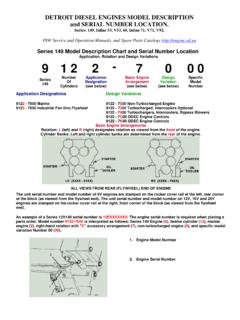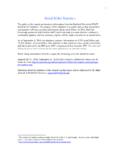Transcription of Guidelines for Project Proposals 2008
1 1 Guidelines for Project Proposals * A technical proposal , often called a "Statement of Work, is a persuasive document. Its objectives are to 1. Identify what work is to be done 2. Explain why this work needs to be done 3. Persuade the reader that the proposers (you) are qualified for the work, have a plausible management plan and technical approach, and have the resources needed to complete the task within the stated time and cost constraints. What makes a good proposal ? One attribute is appearance. A strong proposal has an attractive, professional, inviting appearance. In addition, the information should easy to access.
2 A second attribute is substance. A strong proposal has a well-organized plan of attack. A strong proposal also has technical details because technical depth is needed to sell your Project . Remember: A proposal is a persuasive document. Required Format Format consists of the layout and typography of a document. In formatting your proposal , use the Guidelines in Table 1. A template to produce your proposal exists at the following web page: One aspect of layout is the incorporation of illustrations. In your proposal , each illustration should have a name and be formally introduced in the text.
3 Illustrations consist of figures and tables. Figures include photographs, drawings, diagrams, and graphs. Each figure should have a stand-alone caption, and the key points and features should be labeled. Tables are arrangement of words and numbers into rows and columns. Use tables to summarize lists that the audience will try to find later (the budget, for instance). Table 1. Format Guidelines for requested proposal . Aspect Description Font for headings Boldface serif or sans serif: size in accordance with hierarchy Font for text portion 12-point serif such as Times New Roman or Book Antiqua Margins Standard, at least 1 inch Layout One column, single-sided Paragraphing Indented paragraphs, no line skip between paragraphs in a section Page number Bottom centered Figure names Numbered: Figure 1, Figure 2, Figure 3, and so forth Figure captions Below figure in 10 point type Table names Numbered.
4 Table 1, Table 2, Table 3, and so forth Table headings Above table in 12 point type * Adapted from Guidelines at the Penn State Learning Factory: 2 Organization As given in the proposal template, your proposal should have the following sections and headings: Title Page a. Title of Project in initial capital letters b. The sponsoring company and contact person s name and information c. Team name and individual member names d. Date e. An appropriate picture of the product, a team logo, or both Executive Summary Content: A brief summary of the proposal Length: one-third to one-half page, never more than one page Emphasis: highlighting of the proposed technical and management approach Table of Contents Statement of Problem: the Why?
5 Summary of the request by the sponsor (the original problem statement) Background: Brief description of company and their business Relevance or importance of problem Background information to educate the reader Previous related work by others literature review with credible sources Patent search, if applicable Detailed problem description, as you now understand it Objectives: the What? In the Objectives section, you translate the customer s quantitative and qualitative needs into clear, objective design specifications. Define the scope of work and clearly state the Project objectives, including the following: a. Design specifications in specific, quantitative terms.
6 For example, The plate must be rotated three times at a speed of between 1 and 3 rev/s or Control the temperature of a 1 liter non-insulated standard glass beaker of water to for three hours without temperature deviation. b. Critical design issues, constraints, limitations. Technical Approach: the How? Although you may not know all the details of the problem solution, you should know a first design on how you will attack the problem, and you should have some design concepts. The purpose of this section is to present the process by which you will arrive at the final answer. This section answers the following questions: 3 1) What are the steps in the design process?
7 (Describe and use the nine-step model from Chapter 1 of Hyman s text) 2) What are the benefits and advantages of employing a structured approach to design? 3) How will you generate solution concepts? 4) How will you analyze the performance of your solution? 5) How will you decide on the best alternative? Specific recommendations for this section include the following: a. First, describe your overall design process in general terms. A one-page synopsis of Chapter 1 in the Hyman text would be appropriate here. b. Provide at least three possible solution alternatives and document your methodology to choose the best alternative.
8 Include illustrations such as Figure 1. Try to be as inclusive and creative as possible with your ideas. Strive to achieve at least one non-conventional or out of the box alternative. c. List and describe all the analytical, or computational tools you will employ to analyze your design, such as ProEngineer , SolidWorks , MathCAD, and MATLAB. d. List and detail all the experimental procedures you will use to test your design concepts. e. Evaluate your alternatives based on how well they satisfy the design specifications. Explain the selection criteria by which you will evaluate design alternatives in specific, quantitative terms, such as cost, weight, reliability, ease of use, and ease of manufacture.
9 A matrix table can clearly illustrate this information. f. If possible at this time, rank your solution concepts and list the pros and cons of each. At minimum, state what further information or additional work is needed in order to arrive at a final solution alternative. g. If any solution is totally unfeasible (or may have been Figure 1. SolidWorks model of a tried before), state the reason for its elimination. Manual filter wheel with C-Mount adapters. Project Management: How and When? The Project Management section describes how the Project will be managed, including a detailed timetable with milestones.
10 Specific items to include in this section are as follows: a. Description of task phases (typical development tasks: Planning, Concept Development, System-Level Design, Detailed Design, Testing and Refinement, Production) b. Division of responsibilities and duties among team members c. Timeline with milestones: Gantt chart (see Figure 2 for an example). The following are required elements of your Gantt chart : i. Project duration is from the date your Project is assigned to the completion date: 25th April ii. Each milestone is to be labeled with a title iii. Schedule all tasks not just Design or Testing.





